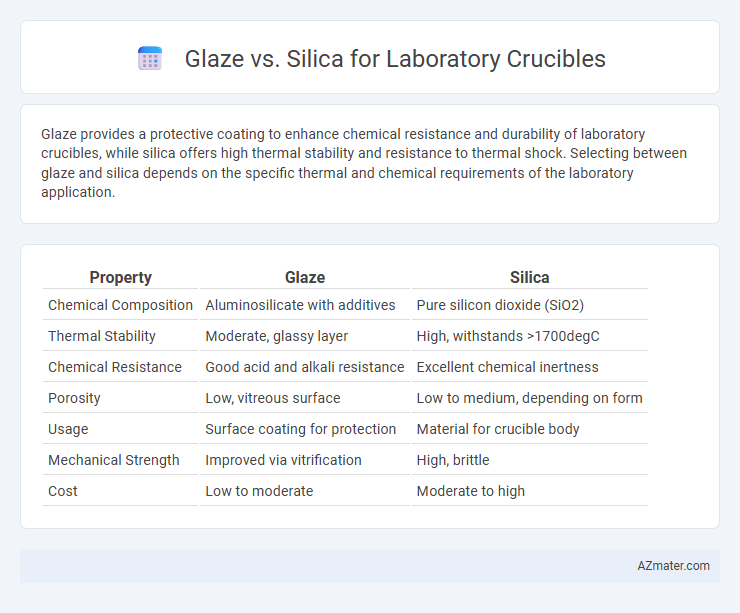Glaze provides a protective coating to enhance chemical resistance and durability of laboratory crucibles, while silica offers high thermal stability and resistance to thermal shock. Selecting between glaze and silica depends on the specific thermal and chemical requirements of the laboratory application.
Table of Comparison
| Property | Glaze | Silica |
|---|---|---|
| Chemical Composition | Aluminosilicate with additives | Pure silicon dioxide (SiO2) |
| Thermal Stability | Moderate, glassy layer | High, withstands >1700degC |
| Chemical Resistance | Good acid and alkali resistance | Excellent chemical inertness |
| Porosity | Low, vitreous surface | Low to medium, depending on form |
| Usage | Surface coating for protection | Material for crucible body |
| Mechanical Strength | Improved via vitrification | High, brittle |
| Cost | Low to moderate | Moderate to high |
Introduction to Laboratory Crucibles
Laboratory crucibles are essential tools in chemistry and materials science for high-temperature experiments, requiring materials that withstand thermal shock and chemical corrosion. Glaze coatings provide a smooth, non-porous surface to crucibles, minimizing contamination and enhancing durability against chemical attacks. Silica, known for its high melting point and thermal stability, is often used in crucibles for applications demanding extreme heat resistance and inertness during chemical reactions.
Overview of Glaze in Laboratory Crucibles
Glaze on laboratory crucibles provides a protective, non-porous coating that enhances chemical resistance and prevents contamination during high-temperature reactions. This vitreous layer improves durability and thermal shock resistance while facilitating easier cleaning and extended crucible lifespan. Compared to unglazed silica, glazed crucibles maintain structural integrity in aggressive environments and reduce sample adherence.
Understanding Silica Crucibles
Silica crucibles, composed primarily of high-purity silicon dioxide, offer exceptional thermal stability and resistance to thermal shock, making them ideal for high-temperature laboratory applications. Their low thermal expansion coefficient prevents cracking during rapid temperature changes, preserving sample integrity and ensuring accurate experimental results. The superior chemical inertness of silica crucibles minimizes contamination risks compared to glazed alternatives, enhancing precision in sensitive analytical procedures.
Material Composition: Glaze vs Silica
Glaze for laboratory crucibles typically consists of a glassy, vitreous coating made from silica combined with fluxes like feldspar and kaolin, enhancing chemical resistance and surface smoothness. Silica crucibles are primarily composed of high-purity quartz (SiO2), providing superior thermal stability and chemical inertness at high temperatures. The distinct material composition makes glaze-coated crucibles more resistant to chemical attack while pure silica crucibles excel in high-temperature applications with minimal contamination risk.
Thermal Stability and Resistance Comparison
Glaze coatings on laboratory crucibles provide enhanced thermal stability by forming a protective glassy layer that minimizes reactive interaction with molten materials at temperatures up to 1300degC. Silica crucibles exhibit excellent thermal resistance withstanding extreme temperatures exceeding 1600degC, maintaining structural integrity without deformation or contamination. Compared to glaze, silica offers superior durability in high-temperature applications, but glaze-treated crucibles provide better chemical resistance against corrosive substances.
Chemical Reactivity and Contamination Risk
Glaze-coated laboratory crucibles exhibit lower chemical reactivity due to their protective glassy layer, minimizing interactions with acidic or alkaline substances, whereas silica crucibles offer high purity but can be more reactive with strong alkalis at elevated temperatures. Silica's high thermal stability reduces contamination risk from thermal degradation, but its porous nature may allow adsorption of trace elements, leading to potential cross-contamination in sensitive analyses. Glaze surfaces provide a smoother, less porous barrier that limits sample adherence and contamination, making them preferable for applications requiring minimal chemical interference.
Mechanical Strength and Durability
Glaze coatings on laboratory crucibles enhance surface hardness, improving resistance to abrasion and chemical attack, thereby increasing mechanical strength and durability during high-temperature experiments. Silica crucibles, composed primarily of high-purity fused silica, offer exceptional thermal shock resistance and maintain mechanical integrity under extreme thermal cycling, making them highly durable for repeated heating and cooling processes. Choosing between glaze and silica depends on specific experimental conditions, with glaze providing enhanced surface durability and silica delivering superior thermal and mechanical stability.
Applications and Suitability in the Laboratory
Glaze coatings on laboratory crucibles provide enhanced chemical resistance and smooth surfaces, making them ideal for handling corrosive materials and preventing contamination during high-temperature experiments. Silica crucibles, known for their exceptional thermal stability and resistance to thermal shock, are suitable for processes involving rapid temperature changes and high-temperature melting applications. Selection between glaze and silica depends on specific laboratory needs, with glaze favored for chemical inertness and silica preferred for thermal durability.
Cost and Availability Factors
Glaze-coated laboratory crucibles generally offer lower upfront costs and are widely available due to common manufacturing processes, making them accessible for routine applications. Silica crucibles, while more expensive, provide superior thermal stability and chemical resistance, often justifying their higher price in specialized high-temperature or corrosive environments. Availability of silica crucibles may be limited in some regions, necessitating longer lead times compared to the more commonly stocked glaze crucibles.
Choosing the Right Crucible: Glaze vs Silica
Selecting the right laboratory crucible depends on the chemical resistance and thermal stability required; silica crucibles offer excellent high-temperature tolerance and purity, making them ideal for fusion and high-temperature applications. Glaze-coated crucibles provide enhanced resistance to corrosive materials and mechanical durability but may not withstand the extreme temperatures that silica can endure. Understanding the specific testing conditions and chemical exposure ensures optimal crucible performance and longevity in laboratory processes.

Infographic: Glaze vs Silica for Laboratory Crucible
 azmater.com
azmater.com